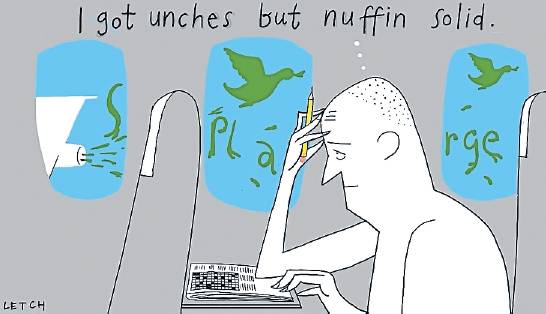WORDPLAY
DAVIDASTLE.COM TWITTER: @DONTATTEMPT
David Astle
Splatch! When a bird flies into a jet engine, the engine usually wins. The pilot slang for such a mess is snarge, a grisly blend of snot and garbage, otherwise known as BASH – Bird Aircraft Strike Hazard.
Gorily this last acronym echoes the jargon of hospital corridors, the veiled speech of doctors and nurses resorting to UBI (Unexplained Beer Injury), LOLINAD (Little Old Lady In No Acute Distress) and ART (Assuming Room Temperature).
Soldiers, waiters, IT geeks – every sector has its argot, as does the crossword biz. At the risk of being ousted from the cruciverbal federation, I’ll give the glossary a bash, not to be confused with a luckless bird in a turbofan.
Here then is a rundown of inside idiom for curious solvers only: Unch is first, short for unchecked square.
Typically a cryptic has both unches and crossover squares (where two words overlap). US puzzles in contrast have zero unches, their grids devoted to white expanses, ensuring every letter is recruited in two directions.
Next comes Nina, a nod to Nina Hirschfeld, the daughter of New York cartoonist, Al. So besotted was Al by his baby girl, born 1945, the artist embedded NINA into his celebrity portraits, hiding the letters in fabric and curls, drapes and bling.
Consequently, any crossword to bear a secret message, often aligned along unches or clue initials, is dubbed a Nina.
Natick is a second US import, slang for any intersection where you’re clueless to salvage either answer. Well, not clueless exactly, but the clues don’t help. Imagine you’re stumped by ‘‘Heidi’s author’’ (SPYRI) or ‘‘Jungle rodent’’ (COYPU), making that blank Y-square one gnarly Natick.
The term was coined by crossword blogger Rex Parker, after hitting a wall in 2008, confronted with ‘‘Treasure Island illustrator, 1911’’ (NC WYETH) and ‘‘Town at 8th mile of the Boston Marathon’’ (NATICK). The junction was a stalemate, the stymie yielding the neologism.
Moving more into cryptopia, regular solvers will tell you that a cryptic clue is split into wordplay and definition (or vice versa). Here’s an example: ‘‘Squashed bird angers founders (6).’’ As soon as ANGERS founders, those six letters faltering in order, you spell SNARGE. Thus goes the standard anagram recipe.
Trouble arises, however, when cryptic setters move from letterplay to definition formulas, enlisting an answer’s elements in a non-cryptic way. SCARECROW, say, can’t be clued as ‘‘Figure in the field to spook black bird’’ because a scarecrow is called a scarecrow as it scares crows. Such a clunker is dubbed a hookworm, since hookworms are hookworms because they are, well, hook-shaped worms. Either you camouflage an answer’s parts with fresh interpretations or you face the heresy of hookworming.
Monk in The Independent recently erred with JUMP JET. His clue (‘‘Leap by black fighter’’) may seem neat but the chicanery is wonky. Why? Any pilot knows a jump jet jumps, taking off vertically. And jump, we know, is a stone-cold synonym of leap.
Bookworms are hookworm cousins and harder to spot. Being more erudite, bookworms clumsily collide with an answer’s roots. The port in AIRPORT, say, is best not clued as ‘‘left to a sailor’’, because etymologically both words – the coastal port and a vessel’s portside – draw from the one semantic well.
And while we’re talking shop, add a dash of green paint, slang for any answer familiar enough to qualify as answer (SWIM OFF, BAD HAIRCUT) yet won’t be found in any dictionary.
So, the challenge is set. Next time the conversation turns nerdy in a crosswordy way, just mention Natick’s Nina, or the greenpaint bookworm in last week’s unch-fest, and you’ll blend right in, like snarge.
“
Soldiers, waiters, IT geeks – every sector has its argot , as does the crossword biz.

